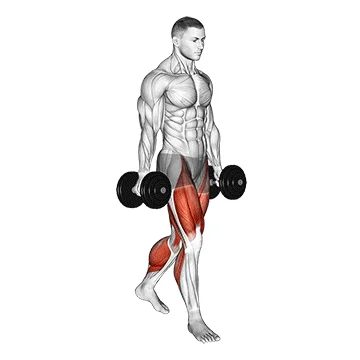Introduction: Unlock the Power of Your Traps
Trying to create striking trap workouts with dumbbells and support your general upper-body strength? You are not on your alone. The best dumbbell trap exercise for enhancing posture, size, and power is offered here in this all-inclusive tutorial.
Strong trapezius muscles are not only a cosmetic target; they are also very vital for shoulder health, neck stability, and general upper body function. Whether your goals are athletic, fitness-oriented, or body-building, learning trap exercises with dumbbells will change the look and strength of your upper body.
Table of Contents
Understanding the Trapezius Muscle: More Than Just a Showpiece
Anatomy of the Traps
The trapezius muscle is a large, triangular muscle that spans the upper back and neck and is divided into three distinct regions:
- Upper Traps: Responsible for shoulder elevation and neck support
- Middle Traps: Key for scapular retraction and shoulder blade movement
- Lower Traps: Critical for shoulder blade depression and overall shoulder stability
Pro Tip: Don’t fall for the myth that traps are just about looking good. These muscles play a vital role in preventing injuries and maintaining proper posture.
Top Dumbbell Trap Exercises: A Comprehensive Breakdown
1. Dumbbell Shrugs: The Classic Trap Builder

Muscles Targeted: Primarily upper trapezius Difficulty: Beginner to Intermediate
Step-by-Step Technique:
- Get on with feet shoulder-width apart.
- Hold dumbbells at either side using a neutral grip.
- Lift your shoulders straight up near your ears.
- Hold just momentarily at the top.
- Slink slowly down to the beginning.
Common Mistakes to Avoid:
- Steers your shoulders away from rolling.
- Stay straight back.
- Control the movement; avoid using momentum.
2. Dumbbell Farmers Walks: Functional Trap and Core Strength

Muscles Targeted: Full trapezius, core, grip strength Difficulty: Intermediate
Technique:
- Choose weight dumbbells.
- Walk with deliberate, under-control steps.
- Retrain shoulders and maintain core engagement.
- Keep up a straight stance.
3. Dumbbell Upright Rows: Precision and Caution

Muscles targeted: deltoids and upper traps. Complication: Middle caution: possible shoulder impingement risk
Proper Form:
- Change the weights to be smaller.
- Slightly raise your elbows above your forearms.
- Draw dumbbells close to your body.
- Stop to avoid shoulder strain at chest height.
Sample Trap Workouts with Dumbbells
Beginner Workout
- Dumbbell Shrugs: 3 sets × 12-15 reps
- Lateral Trap Raises: 3 sets × 10-12 reps
- Prone Trap Raises: 2 sets × 10 reps
Advanced Workout
- Farmers Walk: 4 sets × 30-second intervals
- Dumbbell Upright Rows: 4 sets × 8-10 reps
- Complex Trap Circuit: Alternating shrugs, raises, and walks
Nutrition for Trap Growth
Protein Intake: Aim for 1.6-2.2 grams of protein per kg of body weight. Key Nutrients:
- Lean proteins (chicken, fish, tofu)
- Complex carbohydrates
- Healthy fats
Common Mistakes to Avoid
- Neglecting Form: Prioritize technique over weight
- Overtraining: Allow 48-72 hours of recovery
- Ignoring Other Muscle Groups: Balance is key
Frequently Asked Questions
Q: How often ought I to teach traps? Two to three times a week gives enough time for healing.
Q: Using simple dumbbells, could I create traps? A: Certainly! Effective and flexible trap training comes from dumbbells.
Conclusion
Your road map to a stronger, more developed upper back is dumbbell trap exercises. Remember, your best allies in muscle development are consistency, good form, and progressive overload.
Ready to makeover your traps? Start right now, keep regular, and see how strong you become!
Note: Before beginning any new fitness regimen, always see a healthcare provider.


















